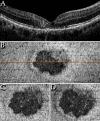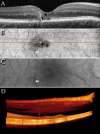The IS/OS junction layer in the natural history of type 2 idiopathic macular telangiectasia
- PMID: 23092925
- PMCID: PMC4606792
- DOI: 10.1167/iovs.12-10765
The IS/OS junction layer in the natural history of type 2 idiopathic macular telangiectasia
Abstract
Purpose: To document the progression of a break in the photoreceptor inner segment/outer segment (IS/OS) junction layer and its functional correlates over time in the natural history of type 2 idiopathic macular telangiectasia (type 2 MacTel).
Methods: Patients with at least 1 year of follow-up were selected from the MacTel Study. En face images were created by manual segmentation of the IS/OS junctional line in volume scans acquired using a spatial-domain optical coherence tomography retinal imaging unit. Retinal sensitivity thresholds were determined using a retinal microperimeter unit. Aggregate retinal sensitivity loss within IS/OS lesions was calculated. Changes over time in an area of IS/OS defects and retinal sensitivity were analyzed.
Results: thirty-nine eyes of 23 patients (mean age: 62.3 ± 9.2 years) were analyzed. Mean follow-up time was 1.9 years (range: 1-3 years). Mean IS/OS break area at baseline was 0.575 mm(2) (SE = 0.092, 95% confidence interval [CI]: 0.394-0.756 mm(2)). The cluster-adjusted mean annual progression rate in IS/OS break area was 0.140 mm(2) (SE = 0.040, 95% CI: 0.062-0.218 mm(2), P < 0.001). Mean aggregate retinal sensitivity loss was at baseline 28.56 dB (SE = 5.43, 95% CI: 17.32-39.80 dB, n = 28), a positive correlation with IS/OS lesion area was present (P < 0.001). The mean annual rate of change in aggregate sensitivity loss was 5.14 dB (SE = 1.51, 95% CI: 2.19-8.10 dB, P < 0.001, n = 37), a significant correlation with lesion area increase was found (P = 0.006).
Conclusions: Both IS/OS break area and rate of enlargement correlate with aggregate retinal sensitivity loss in type 2 MacTel. En face OCT imaging of the IS/OS layer provides a functionally relevant method for documenting disease progression in type 2 MacTel.
Conflict of interest statement
Disclosure:
Figures





References
-
- Gass JD, Oyakawa RT. Idiopathic juxtafoveolar retinal telangiectasis. Arch Ophthalmol. 1982; 100: 769– 780. - PubMed
-
- Gass JD, Blodi BA. Idiopathic juxtafoveolar retinal telangiectasis. Update of classification and follow-up study. Ophthalmology. 1993; 100: 1536– 1546. - PubMed
-
- Gaudric A, Ducos de Lahitte G, Cohen SY, Massin P, Haouchine B. Optical coherence tomography in group 2A idiopathic juxtafoveolar retinal telangiectasis. Arch Ophthalmol. 2006; 124: 1410– 1419. - PubMed
-
- Yannuzzi LA, Bardal AM, Freund KB, Chen KJ, Eandi CM, Blodi B. Idiopathic macular telangiectasia. Arch Ophthalmol. 2006; 124: 450– 460. - PubMed
-
- Maruko I, Iida T, Sekiryu T, Fujiwara T. Early morphological changes and functional abnormalities in group 2A idiopathic juxtafoveolar retinal telangiectasis using spectral domain optical coherence tomography and microperimetry. Br J Ophthalmol. 2008; 92: 1488– 1491. - PubMed
Publication types
MeSH terms
Grants and funding
LinkOut - more resources
Full Text Sources
Research Materials
Miscellaneous

